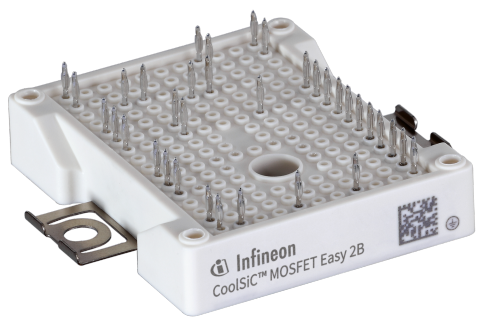FF4MR12W2M1H_B70
CoolSiC™ MOSFET half-bridge module 1200 V
EasyDUAL™ 2B CoolSiC™ MOSFET half-bridge module 1200 V, 4 mΩ G1 with integrated NTC temperature sensor, PressFIT Contact Technology and aluminium nitride ceramic.
Summary of Features
- Best in class with 12.25mm height
- Leading edge WBG material
- Very low module stray inductance
- Enhanced CoolSiC™ MOSFET Gen 1
- Enlarged gate drive voltage window
- Voltage window from 15 to 18 & 0 to -5 V
- Extended maximum gate-source voltages
- Gate-source voltages of +23 V and -10 V
- Tvjop: overload condition up to 175°C
- Integrated NTC temperature sensor
Benefits
- Outstanding module efficiency
- System cost advantages
- System efficiency improvement
- Reduced cooling requirements
- Enabling higher frequency
- Increase of power density
- Thermal conductivity of DCB material
- Better thermal conductivity of DCB material
Applications
PressFIT Technology
Customers of power electronics require ever more modern, easy connection technologies, which also provide a higher reliability to meet the trends to higher temperatures and new applications.
CoolSiC™ MOSFET 1200 V M1H | webcast
CoolSiC™ MOSFET in an EV charging application
With the growing market of electrical vehicles, the industry has put forward more requirements for the performance of charging piles.
This e-learning will show you that the emergence of CoolSiC™ MOSFETs has improved the charging pile industry to make the EV charger smaller, faster and with higher efficiency.
How to choose gate driver for SiC MOSFETs and SiC MOSFET modules
With this training you will learn how to calculate a reference gate resistance value for your Silicon Carbide MOSFET, how to identify suitable gate driving ICs based on peak current and power dissipation requirements and to fine-tune the gate resistance value in laboratory environment based on worst case conditions.
Introduction to SiC reliability
This training covers the properties of Silicon Carbide which change the way how an inverter is designed compared to Si-chips. With that in mind, we explain SiC specific degradation mechanisms and how to ensure that SiC devices survive in the application, considering these special failure modes, by applying the reliability tests Infineon developed. These are internally mandatory for SiC device qualifications to ensure better quality, safety, and reliable device performance for years.





